Cristiano Malossi
Q-SAM2: Accurate Quantization for Segment Anything Model 2
Jun 11, 2025Abstract:The Segment Anything Model 2 (SAM2) has gained significant attention as a foundational approach for promptable image and video segmentation. However, its expensive computational and memory consumption poses a severe challenge for its application in resource-constrained scenarios. In this paper, we propose an accurate low-bit quantization method for efficient SAM2, termed Q-SAM2. To address the performance degradation caused by the singularities in weight and activation distributions during quantization, Q-SAM2 introduces two novel technical contributions. We first introduce a linear layer calibration method for low-bit initialization of SAM2, which minimizes the Frobenius norm over a small image batch to reposition weight distributions for improved quantization. We then propose a Quantization-Aware Training (QAT) pipeline that applies clipping to suppress outliers and allows the network to adapt to quantization thresholds during training. Our comprehensive experiments demonstrate that Q-SAM2 allows for highly accurate inference while substantially improving efficiency. Both quantitative and visual results show that our Q-SAM2 surpasses existing state-of-the-art general quantization schemes, especially for ultra-low 2-bit quantization. While designed for quantization-aware training, our proposed calibration technique also proves effective in post-training quantization, achieving up to a 66% mIoU accuracy improvement over non-calibrated models.
VP Lab: a PEFT-Enabled Visual Prompting Laboratory for Semantic Segmentation
May 21, 2025Abstract:Large-scale pretrained vision backbones have transformed computer vision by providing powerful feature extractors that enable various downstream tasks, including training-free approaches like visual prompting for semantic segmentation. Despite their success in generic scenarios, these models often fall short when applied to specialized technical domains where the visual features differ significantly from their training distribution. To bridge this gap, we introduce VP Lab, a comprehensive iterative framework that enhances visual prompting for robust segmentation model development. At the core of VP Lab lies E-PEFT, a novel ensemble of parameter-efficient fine-tuning techniques specifically designed to adapt our visual prompting pipeline to specific domains in a manner that is both parameter- and data-efficient. Our approach not only surpasses the state-of-the-art in parameter-efficient fine-tuning for the Segment Anything Model (SAM), but also facilitates an interactive, near-real-time loop, allowing users to observe progressively improving results as they experiment within the framework. By integrating E-PEFT with visual prompting, we demonstrate a remarkable 50\% increase in semantic segmentation mIoU performance across various technical datasets using only 5 validated images, establishing a new paradigm for fast, efficient, and interactive model deployment in new, challenging domains. This work comes in the form of a demonstration.
Show or Tell? Effectively prompting Vision-Language Models for semantic segmentation
Mar 25, 2025Abstract:Large Vision-Language Models (VLMs) are increasingly being regarded as foundation models that can be instructed to solve diverse tasks by prompting, without task-specific training. We examine the seemingly obvious question: how to effectively prompt VLMs for semantic segmentation. To that end, we systematically evaluate the segmentation performance of several recent models guided by either text or visual prompts on the out-of-distribution MESS dataset collection. We introduce a scalable prompting scheme, few-shot prompted semantic segmentation, inspired by open-vocabulary segmentation and few-shot learning. It turns out that VLMs lag far behind specialist models trained for a specific segmentation task, by about 30% on average on the Intersection-over-Union metric. Moreover, we find that text prompts and visual prompts are complementary: each one of the two modes fails on many examples that the other one can solve. Our analysis suggests that being able to anticipate the most effective prompt modality can lead to a 11% improvement in performance. Motivated by our findings, we propose PromptMatcher, a remarkably simple training-free baseline that combines both text and visual prompts, achieving state-of-the-art results outperforming the best text-prompted VLM by 2.5%, and the top visual-prompted VLM by 3.5% on few-shot prompted semantic segmentation.
Outline-Guided Object Inpainting with Diffusion Models
Feb 26, 2024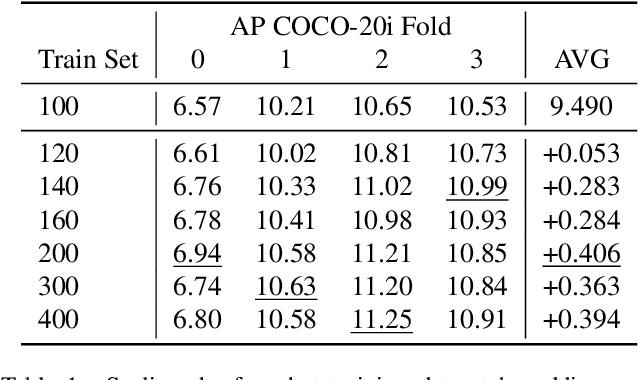

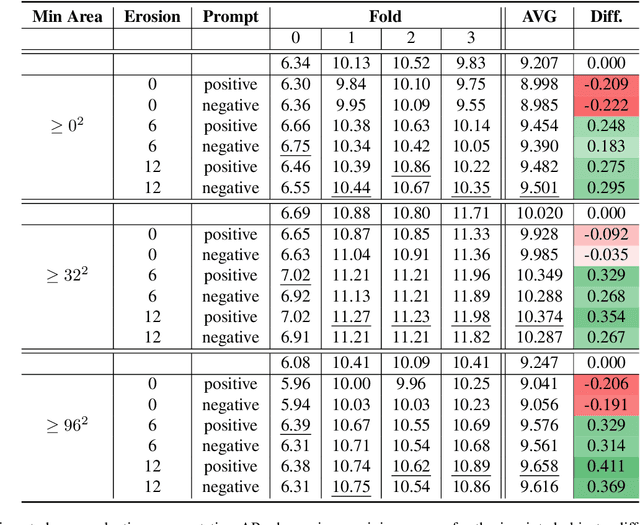
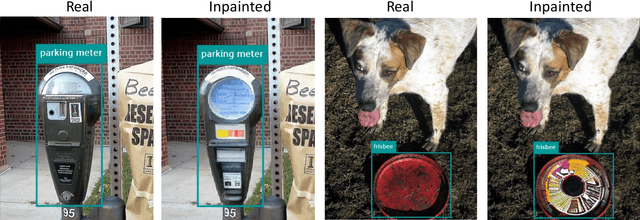
Abstract:Instance segmentation datasets play a crucial role in training accurate and robust computer vision models. However, obtaining accurate mask annotations to produce high-quality segmentation datasets is a costly and labor-intensive process. In this work, we show how this issue can be mitigated by starting with small annotated instance segmentation datasets and augmenting them to effectively obtain a sizeable annotated dataset. We achieve that by creating variations of the available annotated object instances in a way that preserves the provided mask annotations, thereby resulting in new image-mask pairs to be added to the set of annotated images. Specifically, we generate new images using a diffusion-based inpainting model to fill out the masked area with a desired object class by guiding the diffusion through the object outline. We show that the object outline provides a simple, but also reliable and convenient training-free guidance signal for the underlying inpainting model that is often sufficient to fill out the mask with an object of the correct class without further text guidance and preserve the correspondence between generated images and the mask annotations with high precision. Our experimental results reveal that our method successfully generates realistic variations of object instances, preserving their shape characteristics while introducing diversity within the augmented area. We also show that the proposed method can naturally be combined with text guidance and other image augmentation techniques.
Active Learning for Imbalanced Civil Infrastructure Data
Oct 19, 2022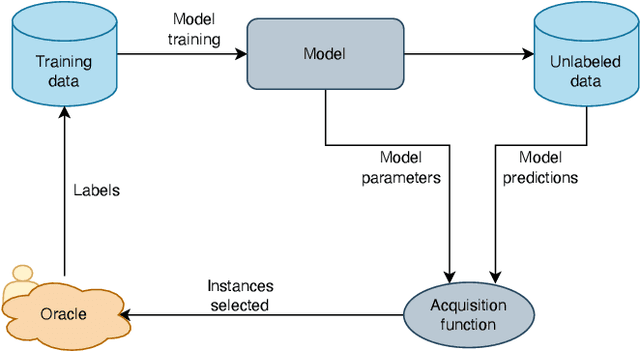
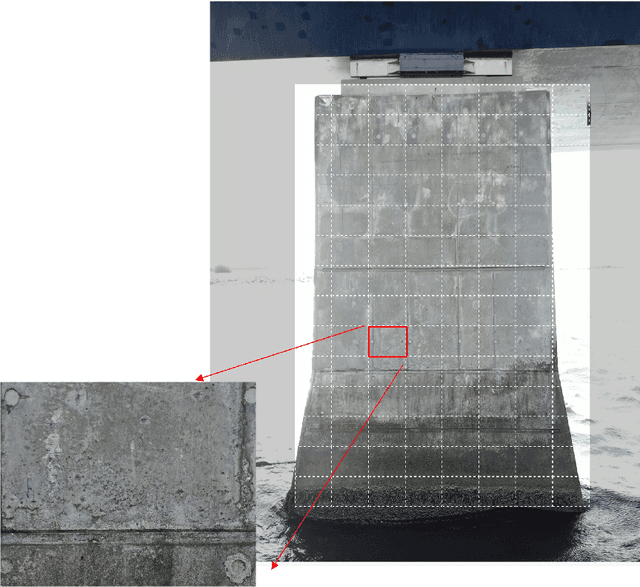
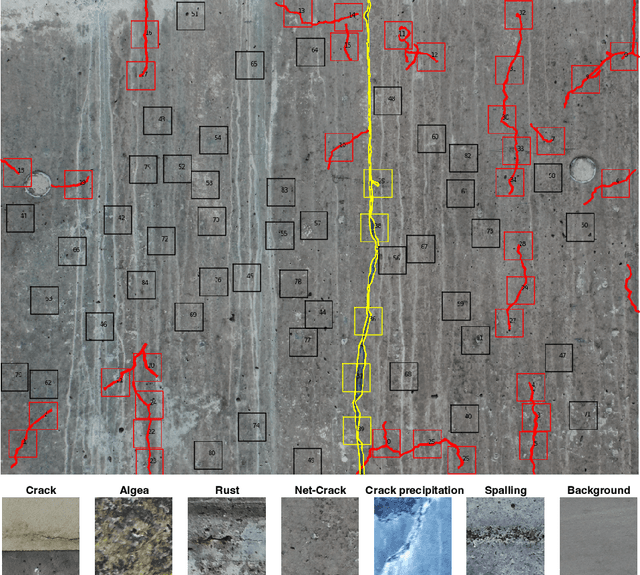
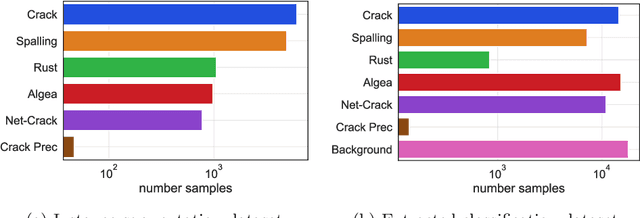
Abstract:Aging civil infrastructures are closely monitored by engineers for damage and critical defects. As the manual inspection of such large structures is costly and time-consuming, we are working towards fully automating the visual inspections to support the prioritization of maintenance activities. To that end we combine recent advances in drone technology and deep learning. Unfortunately, annotation costs are incredibly high as our proprietary civil engineering dataset must be annotated by highly trained engineers. Active learning is, therefore, a valuable tool to optimize the trade-off between model performance and annotation costs. Our use-case differs from the classical active learning setting as our dataset suffers from heavy class imbalance and consists of a much larger already labeled data pool than other active learning research. We present a novel method capable of operating in this challenging setting by replacing the traditional active learning acquisition function with an auxiliary binary discriminator. We experimentally show that our novel method outperforms the best-performing traditional active learning method (BALD) by 5% and 38% accuracy on CIFAR-10 and our proprietary dataset respectively.
Model-Assisted Labeling via Explainability for Visual Inspection of Civil Infrastructures
Sep 22, 2022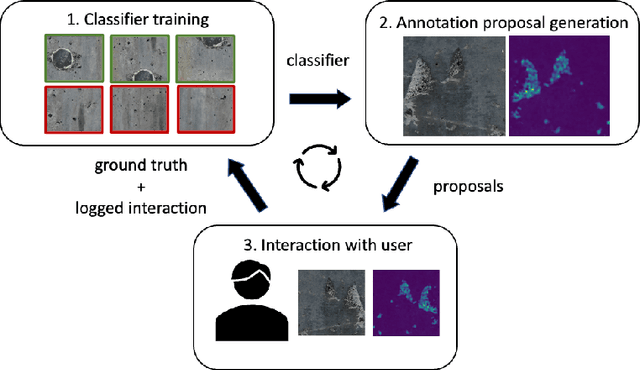
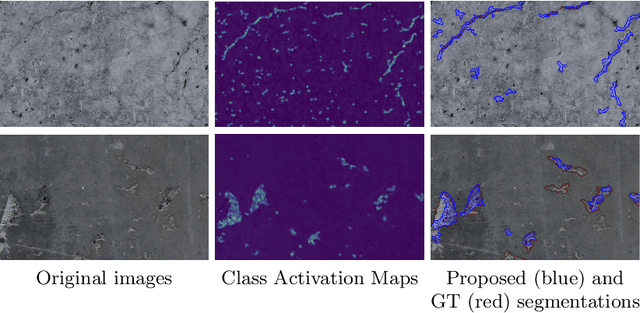

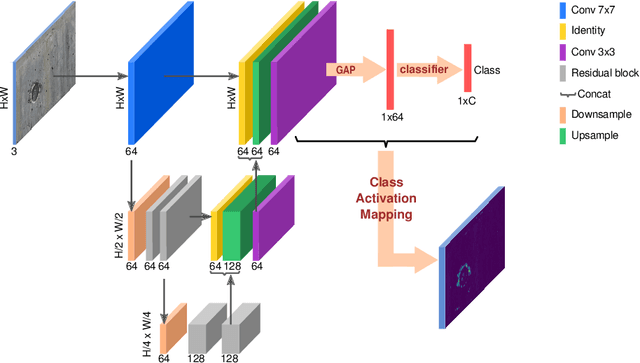
Abstract:Labeling images for visual segmentation is a time-consuming task which can be costly, particularly in application domains where labels have to be provided by specialized expert annotators, such as civil engineering. In this paper, we propose to use attribution methods to harness the valuable interactions between expert annotators and the data to be annotated in the case of defect segmentation for visual inspection of civil infrastructures. Concretely, a classifier is trained to detect defects and coupled with an attribution-based method and adversarial climbing to generate and refine segmentation masks corresponding to the classification outputs. These are used within an assisted labeling framework where the annotators can interact with them as proposal segmentation masks by deciding to accept, reject or modify them, and interactions are logged as weak labels to further refine the classifier. Applied on a real-world dataset resulting from the automated visual inspection of bridges, our proposed method is able to save more than 50\% of annotators' time when compared to manual annotation of defects.
Enabling Reproducibility and Meta-learning Through a Lifelong Database of Experiments (LDE)
Feb 23, 2022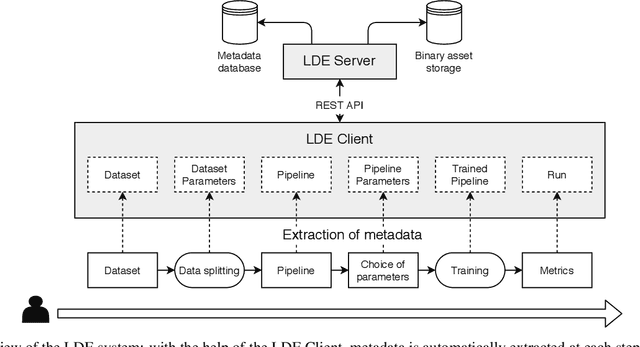
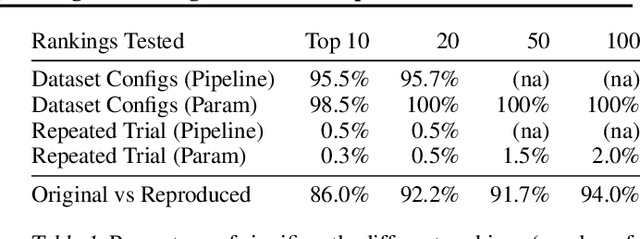
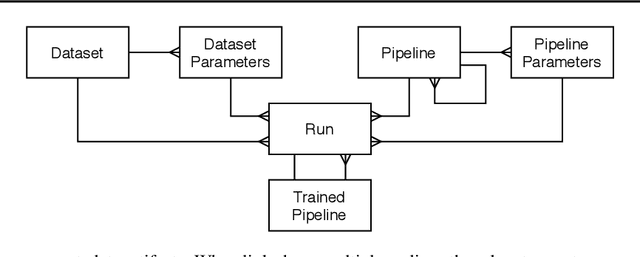
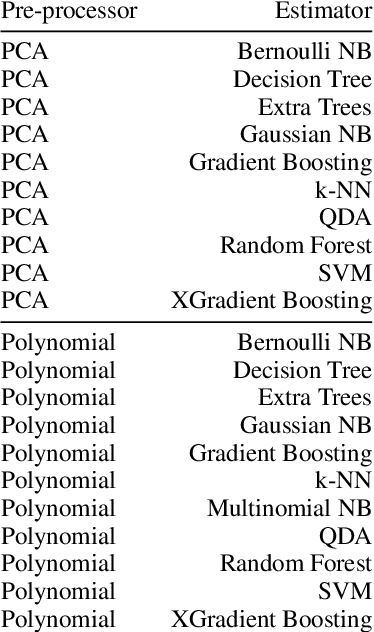
Abstract:Artificial Intelligence (AI) development is inherently iterative and experimental. Over the course of normal development, especially with the advent of automated AI, hundreds or thousands of experiments are generated and are often lost or never examined again. There is a lost opportunity to document these experiments and learn from them at scale, but the complexity of tracking and reproducing these experiments is often prohibitive to data scientists. We present the Lifelong Database of Experiments (LDE) that automatically extracts and stores linked metadata from experiment artifacts and provides features to reproduce these artifacts and perform meta-learning across them. We store context from multiple stages of the AI development lifecycle including datasets, pipelines, how each is configured, and training runs with information about their runtime environment. The standardized nature of the stored metadata allows for querying and aggregation, especially in terms of ranking artifacts by performance metrics. We exhibit the capabilities of the LDE by reproducing an existing meta-learning study and storing the reproduced metadata in our system. Then, we perform two experiments on this metadata: 1) examining the reproducibility and variability of the performance metrics and 2) implementing a number of meta-learning algorithms on top of the data and examining how variability in experimental results impacts recommendation performance. The experimental results suggest significant variation in performance, especially depending on dataset configurations; this variation carries over when meta-learning is built on top of the results, with performance improving when using aggregated results. This suggests that a system that automatically collects and aggregates results such as the LDE not only assists in implementing meta-learning but may also improve its performance.
Generating Efficient DNN-Ensembles with Evolutionary Computation
Sep 18, 2020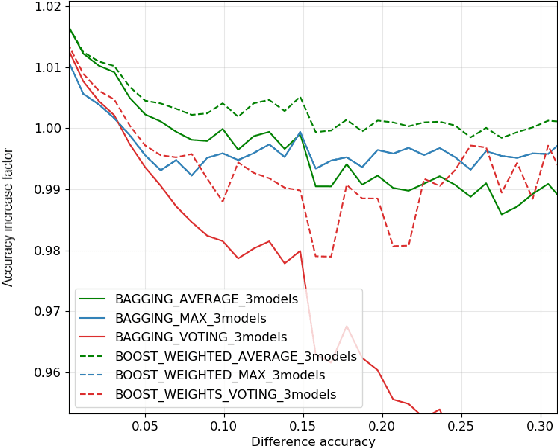
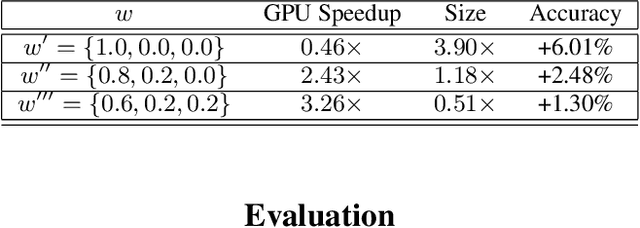
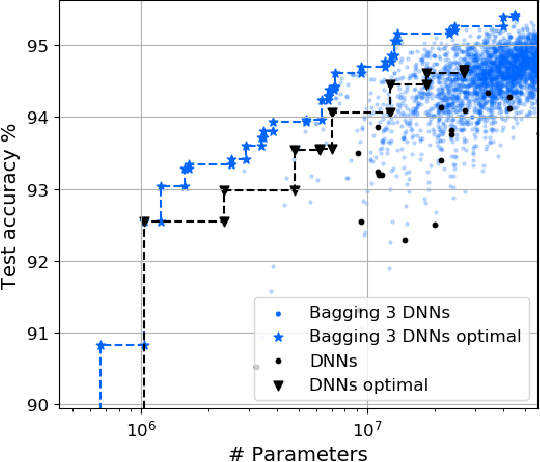
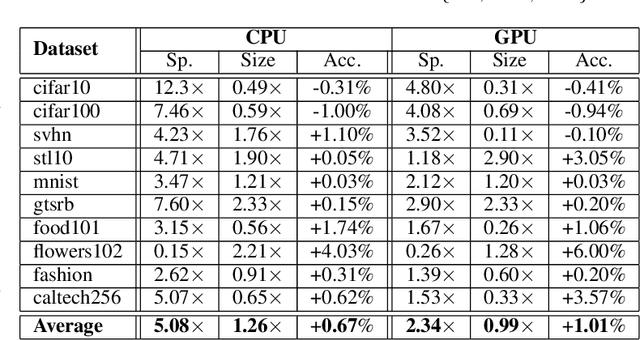
Abstract:In this work, we leverage ensemble learning as a tool for the creation of faster, smaller, and more accurate deep learning models. We demonstrate that we can jointly optimize for accuracy, inference time, and the number of parameters by combining DNN classifiers. To achieve this, we combine multiple ensemble strategies: bagging, boosting, and an ordered chain of classifiers. To reduce the number of DNN ensemble evaluations during the search, we propose EARN, an evolutionary approach that optimizes the ensemble according to three objectives regarding the constraints specified by the user. We run EARN on 10 image classification datasets with an initial pool of 32 state-of-the-art DCNN on both CPU and GPU platforms, and we generate models with speedups up to $7.60\times$, reductions of parameters by $10\times$, or increases in accuracy up to $6.01\%$ regarding the best DNN in the pool. In addition, our method generates models that are $5.6\times$ faster than the state-of-the-art methods for automatic model generation.
Constrained deep neural network architecture search for IoT devices accounting hardware calibration
Sep 24, 2019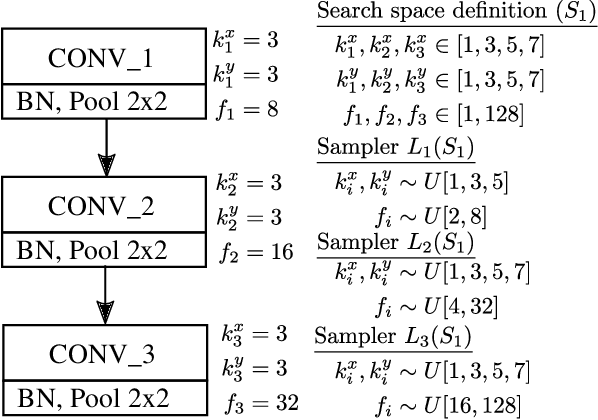
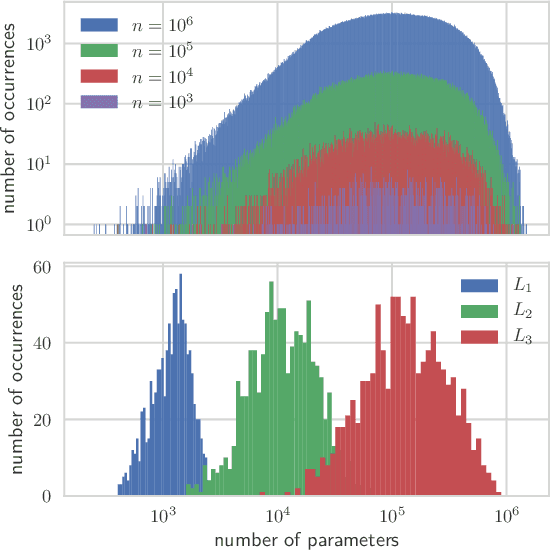
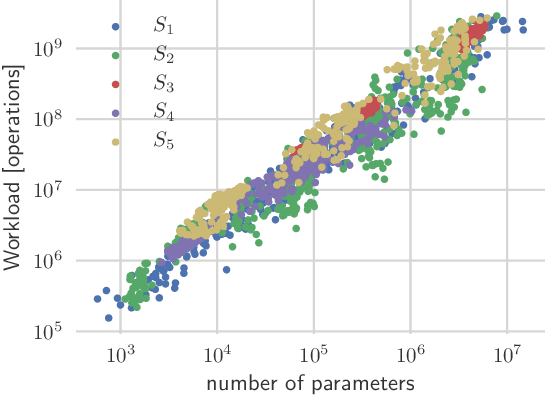
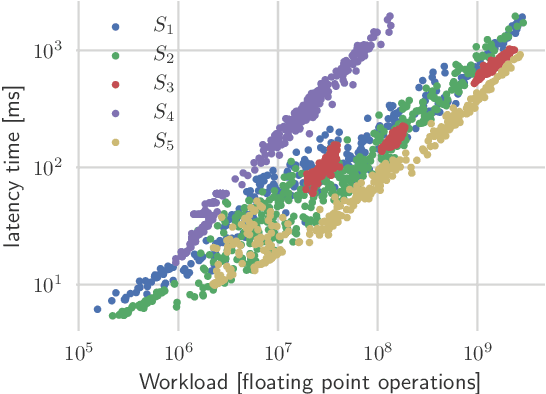
Abstract:Deep neural networks achieve outstanding results in challenging image classification tasks. However, the design of network topologies is a complex task and the research community makes a constant effort in discovering top-accuracy topologies, either manually or employing expensive architecture searches. In this work, we propose a unique narrow-space architecture search that focuses on delivering low-cost and fast executing networks that respect strict memory and time requirements typical of Internet-of-Things (IoT) near-sensor computing platforms. Our approach provides solutions with classification latencies below 10ms running on a $35 device with 1GB RAM and 5.6GFLOPS peak performance. The narrow-space search of floating-point models improves the accuracy on CIFAR10 of an established IoT model from 70.64% to 74.87% respecting the same memory constraints. We further improve the accuracy to 82.07% by including 16-bit half types and we obtain the best accuracy of 83.45% by extending the search with model optimized IEEE 754 reduced types. To the best of our knowledge, we are the first that empirically demonstrate on over 3000 trained models that running with reduced precision pushes the Pareto optimal front by a wide margin. Under a given memory constraint, accuracy is improved by over 7% points for half and over 1% points further for running with the best model individual format.
BAGAN: Data Augmentation with Balancing GAN
Jun 05, 2018

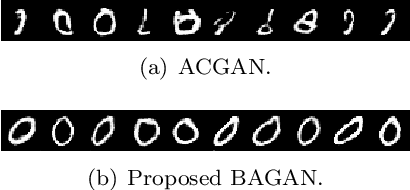

Abstract:Image classification datasets are often imbalanced, characteristic that negatively affects the accuracy of deep-learning classifiers. In this work we propose balancing GAN (BAGAN) as an augmentation tool to restore balance in imbalanced datasets. This is challenging because the few minority-class images may not be enough to train a GAN. We overcome this issue by including during the adversarial training all available images of majority and minority classes. The generative model learns useful features from majority classes and uses these to generate images for minority classes. We apply class conditioning in the latent space to drive the generation process towards a target class. The generator in the GAN is initialized with the encoder module of an autoencoder that enables us to learn an accurate class-conditioning in the latent space. We compare the proposed methodology with state-of-the-art GANs and demonstrate that BAGAN generates images of superior quality when trained with an imbalanced dataset.
 Add to Chrome
Add to Chrome Add to Firefox
Add to Firefox Add to Edge
Add to Edge